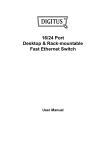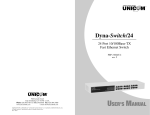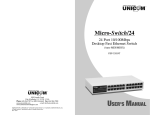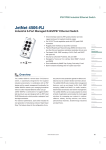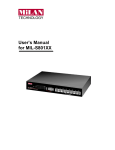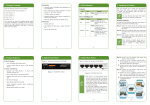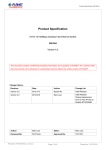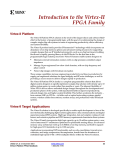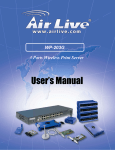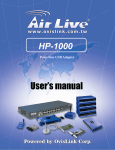Download User's Manual
Transcript
Ether-FSH2400C 24-port 10/100Base-TX Switch User’s Manual FCC STATEMENT This equipment has been tested and found to comply with the limits for a class A device, pursuant to part 15 of the FCC rules. These limits are designed to provide reasonable protection against harmful interference in a commercial installation. This equipment generates uses and can radiate radio frequency energy and, if not installed and used in accordance with instructions, may cause harmful interference on radio communications. Operation of this equipment in a residential area is likely to cause harmful interference, in which case, the user will be requires to correct the interference at the user’s own expense. Content Introduction................................................................ 1 Features................................................................................ 1 Package Contents ................................................................ 2 Ethernet Switching Technology ............................................ 3 Hardware Description................................................ 4 Physical Dimension .............................................................. 4 Front Panel ........................................................................... 4 LED Indicators ...................................................................... 5 Rear Panel............................................................................ 5 Desktop Installation .............................................................. 6 Rack-mounted Installation .................................................... 6 Power On.............................................................................. 7 Network Application .................................................. 8 Troubleshooting ...................................................... 10 Technical Specification........................................... 12 Introduction The AirLive Ether-FSH2400C 24-port 10/100Base-TX Switch is a multi-port Switch that can be used to build high-performance switched workgroup networks. This switch is a store-and-forward device that offers low latency for high-speed networking. The Switch is targeted at workgroup, department or backbone computing environment at SME (small, medium enterprise) business. The 24-port 10/100Base-TX Switch features a “store-and-forward “switching scheme. This allows the switch to auto-learn and store source address on 4K-entry MAC address table. The 24-port 10/100Base-TX switch supports Class of service function. There is no need to configure. The CoS function is included in the switch firmware. It will automatically operate when the switch is operating Features Conforms to IEEE 802.3, 802.3u and 802.3x 24 10/100 Base-TX RJ-45 Ethernet ports Auto-MDIX on all ports IEEE 802.3x flow control support ¾ Flow control on full-duplex ¾ Back pressure on half-duplex N-Way Auto-Negotiation supported Store-and-Forward switching architecture No-blocking full wire speed IEEE802.1p Class of Service Back plane Bandwidth 4.8 Gbps Embedded 1. 5Mbits memory buffer 4K MAC address table 1 Optional long racks mount kit for 19” rack. Package Contents Unpack the contents of the 24-port 10/100Base-TX Switch and verify them against the checklist below. 24-port 10/100Base-TX Switch CD contents (this User Manual) Long Rack Mount kits (Optional) Power Cord Four Rubber Feet 24-port 10/100Base-TX Switch CD (User manual) Long Rack-Mount Kits Power Cord Rubber Feet Package Contents Compare the contents of your 24-port 10/100Base-TX Switch package with the standard checklist above. If any item is missing or damaged, please contact your local dealer for service. 2 Ethernet Switching Technology Ethernet Switching Technology dramatically boosted the total bandwidth of a network, eliminated congestion problems inherent with Carrier Sense multiple access with Collision Detection (CSMA/CD) protocol, and greatly reduced unnecessary transmissions. This revolutionized networking. First, by allowing two-way, simultaneous transmissions over the same port (Full-duple), which essentially doubled the bandwidth. Second, by reducing the collision domain to a single switch-port, which eliminated the need for carrier sensing. Third, by using the store-and-forward technology’s approach of inspecting each packet to intercept corrupt or redundant data, switching eliminated unnecessary transmission that slow the network. By employing address learning, which replaced the inefficient receiving port. Auto-negotiation regulates the speed and duplex of each port, based on the capability of both devices. Flow-control allows transmission from a 100Mbps node to a 10Mbps node without loss of data. Auto-negotiation and flow-control may require disablement for some networking operations involves legacy equipment. Disabling the auto-negotiation is accomplished by fixing the speed or duplex of a port. Ethernet Switching Technology supplied higher performance at costs lower than other solutions. Wider bandwidth, no congestion, and the reduction in traffic is why switching is replacing expensive routers and inefficient hubs as the ultimate networking solution. Switching brought a whole new way of thinking to networking. 3 Hardware Description This section mainly describes the hardware of the 24-port 10/100Base-TX Switch, and gives a physical and functional overview of the Switch. Physical Dimension The physical dimension of the 24-port 10/100Base-TX Switch is 250mmx 133 mm x 37mm (L x W x H) Front Panel The front panel of the 24-port 10/100Base-TX Switch consists of 24x 10/100Base-TX RJ-45 ports. The LED Indicators are also located on the front panel of the Switch. Front panel of the 24-port 10/100Base-TX Switch RJ-45 ports (Auto MDI/MDIX): 24x 10/100Mbps auto-sensing port for 10Base-T or 100Base-TX devices connection. [In general, MDI means connecting to another Hub or Switch while MDIX means connecting to a workstation or PC. Therefore, Auto MDI/MDIX means that you can connect to another switch or workstation without changing non-crossover or crossover cabling.] 4 LED Indicators The LED Indicators gives real-time information of systematic operation status. The following table provides descriptions of LEDs status and their meaning. LED panel LED Power LK/ACT Status Description Green Power On Off Power is not connected Green The port is connecting with the device Blinks The port is receiving or transmitting data Off No device attached The Descriptions of LED Indicators Rear Panel The 3-pronged power plug is located at the rear panel of the 24-port 10/100Base-TX Switch as show in the figure. The Switch will work with AC in the range 100-240V AC, 50-60Hz. 5 The Rear Panel of the 24-port 10/100Base-TX Switch Desktop Installation Set the switch on a sufficiently large flat space with a power outlet nearby. The surface where you put your Switch should be clean, smooth, level and sturdy. Make sure there is enough clearance around the Switch to allow attachment of cables, power cord and allow air circulation. Attaching Rubber Feet 1. Make sure mounting surface on the bottom of the Switch is grease and dust free. 2. Remove adhesive backing from your Rubber Feet. 3. Apply the Rubber Feet to each corner on the bottom of the Switch. These footpads can prevent the Switch from shock/vibration. Attaching Rubber Feet to each corner on the bottom of the Switch Rack-mounted Installation 6 The 24-port 10/100Base-TX Switch has optional come with a long rack-mounted kid and can be mounted in an EIA standard size, 19-inch Rack. The Switch can be placed in a wiring closet with other equipment. Perform the following steps to rack mount the switch: 1. Position one bracket to align with the holes on one side of the switch and secure it with the smaller bracket screws. Then attach the remaining bracket to the other side of the Switch. Attach mounting 2. After attached both mounting brackets, position the 24-port 10/100Base-TX Switch in the rack by lining up the holes in the brackets with the appropriate holes on the rack. Secure the switch to the rack with a screwdriver and the rack-mounting screws. Power On Connect the power cord to the power socket on the rear panel of the Switch. The other side of power cord connects to the power outlet. The external power supply in the switch works with AC in the voltage range 100-240VAC, frequency 50~60Hz.Check the power indicator on the front panel to see if power is properly supplied. 7 Network Application This section provides you a few samples of network topology in witch the Switch is used. In general, the 24-port 10/100Base-TX Switch is designed as a segment switch. That is, with its large address table (4K MAC address) and high performance, it is ideal for interconnecting networking segments. You can use the 24-port 10/100Base-TX Switch to connect PCs, workstations, and servers to each other by connecting these devices directly to the Switch. The switch automatically learns nodes address, which are subsequently used to filter and forward all traffic based on the destination address. By using Uplink port, the Switch can connect with another switch or hub to interconnect each of your small-switched workgroups to form a larger switched network. Small Workgroup The 24-port 10/100Base-TX Switch can be used as a standalone switch to which personal computers, server, printer server, are directly connect to form small workgroup. Small Workgroup Application 8 Segment Bridge For enterprise networks where large data broadcasts are constantly processed, this switch is an ideal solution for department users to connect to the corporate backbone. In the below illustration, two Ethernet switches with PCs, print server, and local server attached, are both connect to the 24 10/100Base-TX Switch. All those devices in this network can communicate with each other through the 24-port 10/100Base-TX Switch. Connecting servers to the switch allow other users to access the server’s data. Department Bridge Application 9 Troubleshooting This section is intended to help you solve the most common problems on the 24-port 10/100Base-TX Switch. Incorrect connections Faulty or loose cables Look for loose or obviously faulty connections. If they appear to be OK, make sure the connections are snug. IF that does not correct the problem, try a different cable. Non-standard cables Non-standard and miswired cables may cause numerous network collisions and other network problem, and can seriously impair network performance. A category 5-cable tester is a recommended tool for every 100Base-T network installation. RJ-45 ports: Use unshielded twisted-pair (UTP) or shield twisted-pair ( STP ) cable for RJ-45 connections: 100Ω Category 3, 4 or 5 cable for 10Mbps connections or 100Ω Category 5 cable for 100Mbps connections. Also be sure that the length of any twisted-pair connection does not exceed 100 meters (328 feet). Improper Network Topologies It is important to make sure that you have a valid network topology. Common topology faults include excessive cable length and too many repeaters (hubs) between end nodes. In addition, you should make sure that your network topology contains no data path loops. Between any two ends nodes, there should be only one active cabling path at any time. 10 Data path loops will cause broadcast storms that will severely impact your network performance. Diagnosing LED Indicators The switch can be easily monitored through panel indicators to assist in identifying problems, which describes common problems you may encounter and where you can find possible solutions. If the power indicator does turn on when the power cord is plugged in, you may have a problem with power cord. Than check for loose power connections, power losses or surges at power outlet. IF you still cannot resolve the problem, contact your local dealer for assistance. 11 Technical Specification This section provides the specifications of 24-port 10/100Base-TX Switch, and the following table lists these specifications. IEEE 802.3 10BASE-T Ethernet Standard IEEE 802.3u 100BASE-TX Fast Ethernet IEEE802.3x Flow Control and Back-pressure IEEE802.1p Class of Service Protocol CSMA/CD Technology Store and Forward switching architecture Transfer Rate Packet size support 14,880 pps Ethernet port 148,800 pps Fast Ethernet port 64 to 1536Bytes MAC address 4K Mac address table Memory Buffer 1.5Mbits 10BASE-T: 2-pair UTP/STP Cat. 3, 4, 5 cable Network Cable EIA/TIA-568 100-ohm (100m) 100BASE-TX: 2-pair UTP/STP Cat. 5 cable EIA/TIA-568 100-ohm (100m) LED Indicators Per port: Link/Activity Per unit: Power Back-plane 4.8Gbps Dimensions 250mmx 133 mm x 37mm (L x W x H) 12 Per port 2 Queues for IEEE 802.1p class of service and support IEEE802.1Q VLAN tag based priority rule, it will recognize 3 bits of precedence carried by the VLAN tag and map it to the specified priority queue. The packet with 0~3 precedence value will flow to low Class of service queue and with 4~7 will flow to high queue. It also supports weight round ration for high and low queue, the rate is 4:1 (4 high queue packets then 1 low queue packet). [Note] There is no need to configure. The CoS function is included in the switch firmware. It will automatically operate when the switch is operating. Operational Temp. Operational Humidity Storage Temp. Power Supply Power Consumption 0℃ to 45℃ (32℉ to 113℉) 10% to 90% (Non-condensing) -10℃ to 70℃ 100-240 VAC, 50~60Hz 10.1 Watts (maximum) EMI FCC Class A, CE Safety UL& cUL, CE/EN60950 13

















